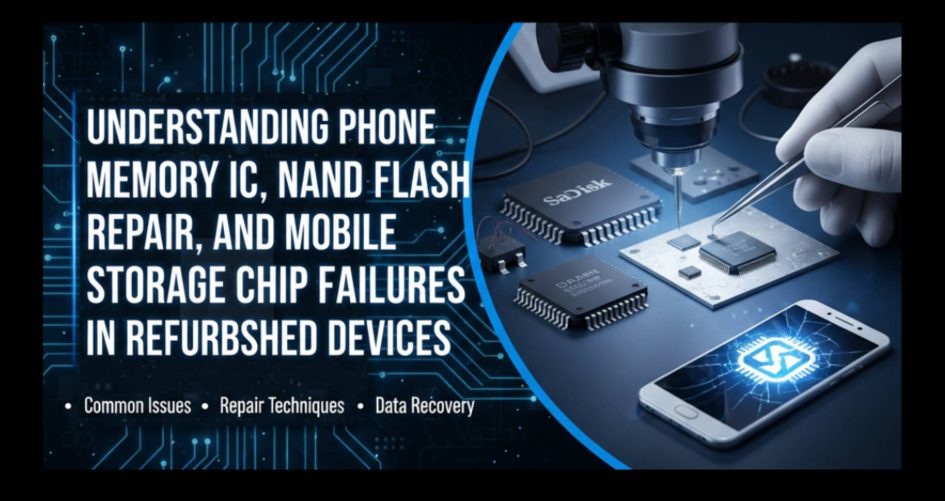When refurbishing devices, phone memory IC, NAND flash repair, and mobile storage chip challenges often emerge as critical failure points. In this article, we’ll explore common causes of these storage‑layer issues, how to diagnose and remediate failures, and best practices for sourcing and verifying components—helping your refurbished mobile wholesale business minimize returns and deliver reliable devices every time. Know more.
1. Why phone memory IC, NAND flash repair, and mobile storage chip issues matter
Smartphone storage is foundational: everything—from the operating system to photos, apps, and system updates—depends on the reliability of the phone memory IC or mobile storage chip. When these fail, even a high‑graded chassis or new display can’t save the device. That’s why NAND flash repair is essential knowledge for any refurb wholesaler focusing on quality and scalability.
2. What is a mobile storage chip and how does it fail?
- A mobile storage chip, often branded UFS or eMMC, holds all onboard data and firmware.
- The phone memory IC is the controller interface that orchestrates reads/writes to the NAND flash.
- Failures stem from wear‑out, thermal stress, manufacturing defects, or improper programming during reflash.
- Over time, NAND flash memory cells degrade and can result in corrupted blocks, bootloops, or device instability.
3. Common failure modes in NAND and memory IC
3.1 Block corruption and bad sectors
Repeated writes wear out auto‑managed blocks. As mobile storage chip dysfunction increases, corrupted filesystem areas manifest preventing boot or causing data loss.
3.2 Controller / IC failure
The phone memory IC may fail electrically—especially common in older phones with solder issues—resulting in bricks, no mountable storage, or continuous reboot loops.
3.3 Firmware mismatches
Improper NAND flash repair, including flash tool misuse or wrong firmware versions, leads to mismatches where the storage chip hardware cannot sync with OS expectations.
3.4 Thermal and mechanical damage
Excessive heat from soldering or mechanical pops can sever solder balls under the mobile storage chip or damage delicate traces on the motherboard, compromising stability.
4. Diagnosing storage‑layer failures in refurbished phones
Accurate diagnostics begin with basic observation and progress through systematic testing.
4.1 Visual / board‑level inspection
Check for burn marks, cracked solder joints around the phone memory IC or chip area. Any darkened spots or lifted pads warrant deeper testing.
4.2 Software diagnostics and flash tools
Boot vanilla recovery or fastboot. Attempt to read storage partitions. If odd block errors or access timeouts occur, suspect NAND flash repair issues or failing mobile storage chip.
4.3 Specialized test equipment
Use flash emulators and SPI/UFS sniffers to debug communication lines directly with the phone memory IC. Monitor voltages and detect repeated retry fail patterns.
4.4 Thermal and stress tests
Cycle device temperatures and run I/O stress tools to provoke intermittent failures in the mobile storage chip. This helps catch latent issues that manifest after a day or shift.
5. Troubleshooting and NAND flash repair techniques
5.1 Reballing or rework of the memory IC
If solder joints fail, phone memory IC reballing or BGA reflow may restore connectivity—common in older models. Proper thermal profiles are essential to avoid damaging adjacent components.
5.2 Firmware reprogramming
Use official or trusted ROM images. Match model, region, and storage layout exactly when performing NAND flash repair. Mismatched layouts corrupt partition tables and cause permanent failure.
5.3 Block remapping and bad block tables
Some tools allow dynamic remapping of bad sectors to spare blocks. This NAND flash repair step can revive a device with moderate wear, but not excessively degraded chips.
5.4 Component replacement
If the mobile storage chip or memory IC is physically damaged, replacing it via hot‑swap or grafting from compatible donor boards may be the only fix.
6. Sourcing reliable mobile storage chip and phone memory IC components
When you bring in replacement chips or donor boards, prioritizing quality ensures consistency.
6.1 OEM vs third‑party
Whenever possible, use authentic OEM memory IC modules or UFS/eMMC packages. Third‑party components may have inconsistent endurance, lower yield, or missing firmware compatibility.
6.2 Traceability and batch testing
Ensure your supplier provides lot codes and burn‑in test reports. Test a sample batch performing NAND flash repair procedures yourself to verify reliability before full-scale purchasing.
6.3 Supplier reputation and defect rates
Request data on failure rates post-repair. If a supplier shows <1% post‑flash fault rate, they’re likely trustworthy for bulk sourcing of phone memory IC or mobile storage chip items.
6.4 Compatibility across models
Memory ICs aren’t interchangeable across many Samsung, Xiaomi, or Apple devices. Confirm package layout, pin assignments, and controller compatibility when procuring stock for NAND flash repair operations.
7. Integrating diagnostics and repair into your refurbishment workflow
7.1 Pre‑grading teardown
Open devices early in the grading process to detect damaged phone memory IC or storage chip before cosmetic repair. Flag boards for rework or replacement.
7.2 Automated testing stations
Build test rigs that run flash benchmark tools, block integrity scans, and firmware validation with expected hash checks. Fail devices with anomalies at this stage—before device bundling.
7.3 Tiered repair paths
Set up a “premium repair” path for high‑value phones where you perform full NAND flash repair, reballing or chip replacement. Lower‑tier paths may use donor boards but with documented risk.
7.4 Post‑repair burn‑in
Always run devices through extended burn‑in—especially writing large files, updating the OS, or running stress apps—to ensure stable mobile storage chip operation before shipping.
8. Risks of neglecting NAND flash repair in refurb workflows
Ignoring storage‑layer problems causes these frequent business pain points:
- Higher return rates due to corrupted devices that boot then fail.
- Loss of reputation if customers discover data or OS corruption.
- Increased costs from re‑shipping, re‑mapping bad blocks, or full rework cycles.
- Wasted inventory when donor boards fail earlier than expected.
- Negative Google reviews or poor reseller buyer scores tied to reliability.
9. SEO & marketing leverage around storage chip services
Use the keywords in customer‑facing content to improve indexation and attract repair clients or refurb buddies:
- “Expert phone memory IC diagnostics with full integrity testing.”
- “Advanced NAND flash repair and block remapping services.”
- “Replacement mobile storage chip sourcing and reballing for high success rates.”
This language helps Google understand your specialized offering and drives traffic from relevant search queries.
10. Operational metrics to track
Track these core KPIs to monitor your NAND flash repair and storage‑chip workflow quality:
| KPI | Target Benchmark |
| Post‑repair storage failure rate | ≤ 0.5 % over 30 days |
| Burn‑in stress failure rate | ≤ 1 % before shipping |
| Warranty return rate for storage | ≤ 2 % across all devices |
| Rework cycle count | ≤ 5 % after initial rebuild |
| Supplier defect variance | < 10 % difference month to month |
Consistent metrics help refine sourcing, flag supplier issues, and ensure each batch of mobile storage chip or phone memory IC is up to standard.
11. Case study: resolving storage IC failure at scale
Situation: A wave of mid‑range brand refurb units from a single batch began showing random boot‑loops after firmware update.
Diagnosis: Testing revealed UFS controller failures—multiple blocks went bad, and error rates spiked well above normal. NAND flash repair attempts corrected some but not all units.
Remediation:
- Swapped in known‑good phone memory IC donor modules.
- Performed reflow reballing and remapped bad blocks.
- Conducted 48‑hour stress burn‑in.
- Supplier audit revealed high‑wear chips in that batch.
Result: Return rate dropped from 3.5 % to 0.4 %, warranty requests plummeted, and resale confidence improved.
12. Safety, compliance, and legal considerations
- Ensure encrypted secure erasure before servicing to avoid residual customer data exposure, especially when working with mobile storage chip replacements.
- Dispose of defective flash chips or controllers per e‑waste regulations.
- When sourcing phone memory IC or storage chip donors, verify seller compliance with IP and environmental standards like RoHS or WEEE.
13. Summary: mastering phone memory IC, NAND flash repair, and mobile storage chip workflows
- phone memory IC and mobile storage chip failures are critical drivers of refurb quality problems.
- Knowing when to reflow, reprogram, remap, or replace during NAND flash repair is key to long‑term stability.
- Sourcing authenticated, batch‑tested components reduces defect rates significantly.
- Building testing rigs, burn‑in protocols, and tiered repair flows protects your reputation and profit margins.
- SEO‑optimized pages using these keywords position your business as an expert in storage‑layer refurbishment.
14. Your next steps
- Audit recent returns for storage‑related failures and categorize by failure mode.
- Invest in diagnostic tools for block integrity scanning and IC-level trace logging.
- Source mobile-grade UFS/eMMC controllers from authenticated suppliers for phone memory IC repair.
- Roll out proper burn‑in and stress‑test workflows for refurbished stock.
- Publish content like this blog to highlight your unique storage‑level expertise—building trust with both B2B partners and end users.
Conclusion
When refurbishing mobile devices, phone memory IC, NAND flash repair, and mobile storage chip expertise can make the difference between average refurb quality and standout reliability. By mastering diagnostics, sourcing the right components, and implementing strict testing workflows, you can minimize failures, improve trust, and elevate your refurbished wholesale business. Want help designing a repair flow, sourcing audit, or marketing plan around storage‑chip services? I’d be glad to help. Know more.





